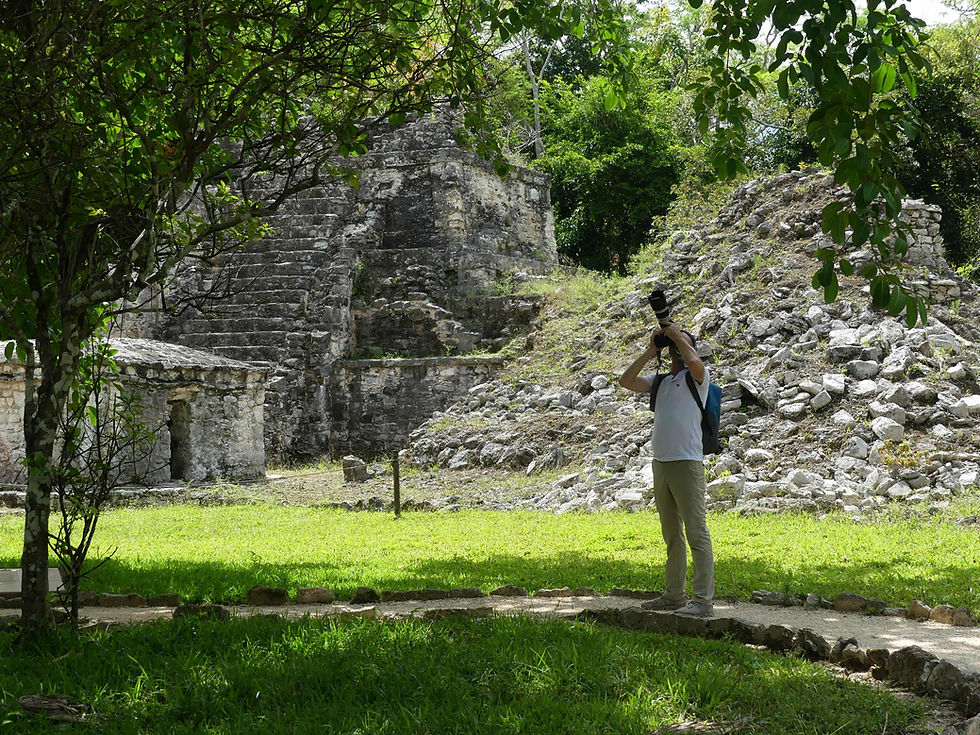Cenote Diving: 7 Best Sites For Cenote Diving in Tulum Mexico
- Info Mexico Kan Tours
- Jun 28, 2023
- 6 min read
Updated: Jun 5

Cenotes have been forming for millions of years, creating natural sinkholes of fresh water due to erosion by rainwater which penetrates the limestone rock and weakens it, eventually leading to collapse. Cenotes are a spectacular part of the landscape of the Yucatan Peninsula, romantically called part of the Mayan Underworld, a labyrinth of underground rivers and flooded caves that have become a Mecca and a playground for divers. Since the 1980's, cave divers started to explore these underwater corridors and discovered a fascinating aquatic system of more than 350 kilometers that they have since been connecting together via new portals of entry: every newly found cenote adds new possibilities of discovery to add to the map of underground rivers.
Thanks to the effort and passion of these adventurers & explorers, we now know that the largest explored underground river on the planet is right here under our feet in the Yucatan: the Sac Actun river. Magnificent formations of stalagmites and stalactites, some of which are tens of thousands of years old, form part of the scenery in this natural cathedral built by nature. There is also a surprising diversity of animals: fish, crustaceans, bats, insects, birds, arachnids and an endless number of fossils are part of the landscape of this universe which seems to be from another time. It is truly like voyaging to a land before time, or indeed, like being on another planet.
Why do cenotes have this otherworldly effect?

Thousands of years ago, the Yucatan Peninsula did not exist, it was under the ocean, part of the seabed. When sea levels dropped and exposed this huge limestone platform, the remains of sea creatures and sea shells, coral and sponges mineralized were embedded in the newly formed rock walls, eventually becoming fossilized. These natural formations can be seen in our Cenote Adventure Tour, one of the best ways to visit a variety of cenotes and see the diversity of life held within.
This aquatic system, called the Great Mayan Aquifer has now achieved international recognition and is constantly being explored. The increased interest and funding to help in its exploration and conservation has led to the creation of the Proyectogam (proyecto Gran Acuífero Maya) , a multi-disciplinary program that combines expertise and investigation from divers, biologists, archaeologists, paleontologists, anthropologists and many others to help broaden our
understanding of the Mayan aquifer and contribute to its preservation.

Divers from all over the world came to the Yucatan Peninsula around Tulum, Merida and Playa del Carmen to experience unique dives into the Mayan underworld and learn about the culture and importance of cenotes in pre- Columbian civilization.
Indeed, in the Mayan culture, cenotes are sacred. They represent Xibalba, what the Maya call the underworld, everything that takes place beneath the earth.
The underworld in mythology represents both world of the dead and the source of life, as the cenotes are reminiscent of the ‘primordial soup’ of life, a dark pool from whence the Earth came and all life proceeded from. They used the cenotes for rituals and ceremonies, particularly linked with fertility and health; but also with death and sometimes used as cemeteries, placing the dead in a context of rebirth, literally ’on the path’ to the Underworld and the next life. This is why many human remains have been found during diving explorations, opening our eyes to the subtle facets of this fascinating culture.
When you visit Tulum, don't miss out on this trip!
And if you want to dive in, we have partnered up with longtime local cave divers to provide you with a high quality and safety oriented cenote diving experience. Flying Fish is an expert in cenote diving with certified dive guides which specialize in cave exploration diving.
To learn more about the history and the process of the formation of all types of the cenotes, you can check Our Guide to the best Cenotes around Tulum article.
Here are some of our favorite cenote dives, including options for beginners certified and expert divers :
** To dive in closed and deep cenote you need to have at least the Open Water certification.
CASA CENOTE - Beginners (First time diving)

Ideal for “discover scuba diving” made simple for a first taste, without committing to a course. The open cenote is 5-6 meters deep and welcomes new divers to test out the equipment and the feeling of scuba. Usually done in a swimming pool, the beauty of Casa Cenote allows you to dive in a controlled environment yet at the same time observe the underwater world. Full of mangrove roots and a mix of freshwater and saltwater fish, this is hands down the best location in the world for a Discover Scuba Dive and for cenote diving for families. Located right in front of the sea, this cenote is fed by springs coming from the underground rivers and is also connected to the ocean . The natural light from the sun rays offers a spectacular view of the mangrove roots which extend into the water, making a home for aquatic life and a breeding ground for fish. Also included on our Cenote Adventure Tour, if you don’t want to dive, snorkel it! A must.
CENOTE ANGELITA - Advanced

It is one of the best cenotes to observe the “halocline”, an astounding underwater phenomenon that occurs in few places and circumstances. It is a natural phenomenon where the freshwater meets the salt water of the ocean forming an underwater cloud. Passing through this cloud is like traveling to a parallel universe. Going down diving in the cenote you can observe the fog very clearly ,it is one meter thick and you will reach it approximately at 25 meters, below there are still 30 meters down where you can observe little aquatic life and vegetation. Once you enter the cloud, you will have a blurred vision, and enjoy the exciting experience. To dive deeper, you need an advanced certification. You will find the Angelita cenote 20 minutes on the Highway 307 road to the town of Muyil.
CENOTE LA PONDEROSA - Open Water
La Ponderosa, also known as Jardín del Edén, is only 3 km / 1.8 miles from Puerto Aventuras and about 25 km / 15.53 miles south of Playa del Carmen. This cenote has an enormous open mouth of access that leaves plenty of space for divers and swimmers. Connected to other nearby cenotes, you will explore the underground between huge blocks of rocks in large open spaces. This is a good introduction for early stage cave diving, as you don't need more experience than an Open Water certificate and can get used to the environment without having to navigate narrow or tight spaces. Take your lamplight with you and let’s dive. At 10 meters you can see the halocline.
CENOTE EL PIT - Advanced

@flyingfish
Located in the depths of the Mayan jungle, El Pit is one of the best cenotes in Mexico for cavern and cave diving in Tulum because it is one of the deepest open spaces. With more than 120 m / 394 ft depth, its appeal includes two haloclines at 12m / 39ft and 15m / 49ft and well known for breathtaking light effects that occur when you are way down looking back up! Indeed the light rays enter this sinkhole and pierce this natural pit, hence the name, until you have an optimal visibility during the descent as if the sun was in the cenote. Watching the divers go down into this luminous cenote is like being in the foreground of an underwater dance show. You will take your best pictures of divers underwater.
CENOTE CHAC MOOL - Open Water
We are talking about The Chac Mool Cenote, whose name for the native Mayans means “Great Red Jaguar”. You will find all the phenomena present in the cenotes with the exception of a large marine fauna. For a unique experience, this cenote is very complete and includes all of the following on a dive: the halocline effect, amazing rock formations, underwater limestone passageways with stalactites and stalagmites, sunbeams & natural light effects, and even an air pocket where divers can surface and enjoy lush vegetation trailing down the walls, hidden to everyone else.
CENOTE DOS OJOS - Open Water

@flyingfish
Maybe the most famous cenote in the Yucatan, you find the Cenote Dos Ojos inside of the Park Dos Ojos, fifteen minutes north from Tulum by car. Although it was discovered in the 80s, its endless corridors are still being explored today. In fact, only last year was it discovered that it is part of the longest cenote cave system in the world, Sac Actun. Home to plenty of aquatic life you can find some freshwater shrimp and also meet the bats hidden in the rocks of the famous BatCave. Be ready to dive between confined sections of rocks. Dos Ojos is also well known for those who prefer to practice snorkeling, so it is a good mix combination activity to do in family or with friends. Everyone can choose his favorite aquatic vibe.
CENOTE TAJMA HA - Open Water
Located next to Xpu-Ha, just 5 km / 3.10 miles from Puerto Aventuras, this cenote is in the middle of the jungle. Among so much vegetation, you will be surprised to find its small entrance, which is nothing more than the gateway to a wonderland. Maximum of 15 meters, this one is spectacular for this light effect show. If you go with the morning sun, you will dive among amazing light sunbeams cutting through the water and further on the roof collapses to change
the light angle and reflection. It’s like walking across different rooms in a museum, you will dive into a timeless world, between the natural art covered limestone walls, stalactites, stalagmites and columns.









Comments